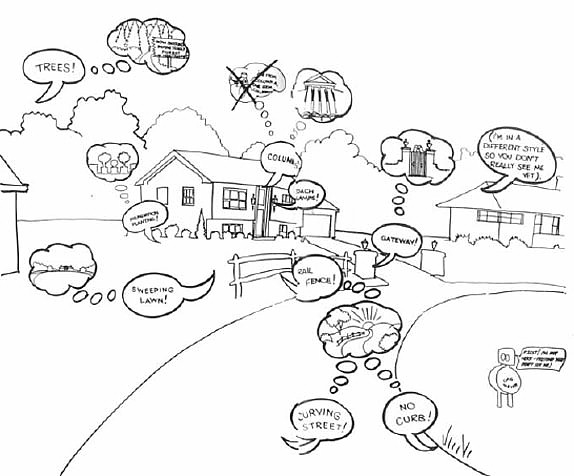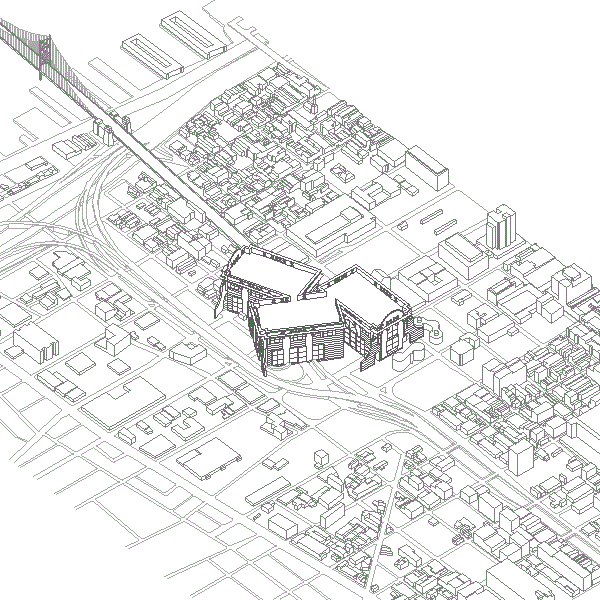2012.01.29 11:39
Looking for Venturi cartoon
To further confuse the issue, see pages 56-58 of The Language of Post-Modern Architecture--interesting theory of movie star homes being "the most influential in popular taste."

For the record, the cartoon above from Learning from Las Vegas is from the "Learning from Levittown" studio at Yale 1970, with the drawing/cartoon by Robert Miller (who might be the inspiration for a fictional client today).
"Following the appearance of Learning from Las Vegas (1972), R. Venturi, D. Scott Brown and S. Izenour had planned the publication of their second Yale research project under the title "Learning from Levittown". This book was never completed, but the research material became the basis for a 1976 exhibition [Signs of Life] in Washington D.C." --Stanilaus von Moos
Eclectic Houses and the Gooding House are both from 1977, and may well be seen as "theory/research into practice." Check out the comparative scales.
And in 1999, hyper-eclectic...

| |
2013.08.29 12:30
Learning from Learning from Las Vegas (again)
Here is an extended passage from the 'Introduction' of Tom Wolfe's The Kandy-Kolored Tangerine-Flake Streamline Baby (1965):
"Jane Holzer--and the Baby Jane syndrome--there's nothing freakish about it. Baby Jane is the hyper-version of a whole new style of life in America. I think she is a very profound symbol. But she is not the super-hyper-version. The super-hyper-version is Las Vegas. I call Las Vegas the Versailles of America, and for specific reasons. Las Vegas happened to be created after the war, with war money, by gangsters. Gangsters happened to be the first uneducated . . . but more to the point, unaristocratic, outside of the aristocratic tradition . . . the first uneducated prole-petty-burgher Americans to have enough money to build a monument to their style of life. They built in an isolated spot, Las Vegas, out in the desert, just like Louis XIV, the Sun King, who purposely went outside of Paris, into the countryside, to create a fantastic baroque environment to celebrate his rule. It is no accident that Las Vegas and Versailles are the only two architecturally uniform cities in Western history. The important thing about the building of Las Vegas is not that the builders were gangsters but that they were proles. They celebrated, very early, the new style of life of America--using the money pumped in by the war to show a prole vision . . . Glamor! . . . of style. The usual thing has happened, of course. Because it is prole, it gets ignored, except on the most sensational level. Yet long after Las Vegas' influence as a gambling heaven has gone, Las Vegas' forms and symbols will be influencing American life. The fantastic skyline! Las vegas' neon sculpture, its fantastic fifteen-story-high display signs, parabolas, boomerangs, rhomboids, trapazoids and all the rest of it, are already the staple design of the American landscape outside of the oldest parts of the oldest cities. They are all over every suburb, every subdivision, every highway . . . every hamlet, as it were, the new crossroads, spiraling Servicenter signs. They are the new landmarks of America, the new guideposts, the new way Americans get their bearings. And yet what do we know about these signs, these incredible pieces of neon sculpture, and what kind of impact they have on people? Nobody seems to know the first thing about it, not even the men who design them. I hunted out some of the great sign makers of Las Vegas, men who design for the Young Electric Sign Co., and the Federal Sign and Signal Corporation--and marvelous!--they come from completely outside the art history tradition of the design schools of the Eastern Universities. I remember talking with this one designer, Ted Blaney, from Federal, their chief designer, in the cocktails lounge of the Dunes Hotel on "The Strip." I showed him a shape, a boomerang shape, that one sees all over Las Vegas, in small signs, huge signs, huge things like the archway entrance to the Desert Inn--it is not an arch, really, but this huge boomerang shape--and I ask him what they, the men who design these things, call it.
Ted was a stocky little guy, very sunburnt, with a pencil mustache and a Texas string tie, the kind that has string sticking through some kind of silver dollar or something situated at the throat. He talked slowly and he had a way of furling his eyebrows around his nose when he did mental calculations such as figuring out this boomerang shape.
He stared at the shape, which he and his brothers in the art have created over and over and over, over, over and over and over in Las Vegas, and finally he said,
"Well, that's what we call--what we sort of call--'free form.'"
Free form! Marvelous! No hung-up old art history words for these guys. America's first unconscious avant-garde! The hell with Mondrian, whoever the hell he is. The hell with Moholy-Nagy, if anybody ever heard of him. Artists for the new age, sculptors for the new style and new money of the . . . Yah! lower orders. The new sensibility--Baby baby baby where did our love go?--the new world, submerged so long, invisible, and new arising, slippery, shiny, electric--Super Scuba-man!--out of the vinyl deeps."
- - - - -
There's no question that Wolfe (already) learned something very new from Las Vegas. And there's no question that this passage precurses and inspired Venturi, Scott Brown and Izenour. What's interesting now is the difference between Wolfe's focus and V,SB&I's focus--a journalistic focus versus an academic focus, sort of. There is also the difference that V,SB&I probably felt they had to introduce so as not be 'copying' Wolfe. For example, V,SB&I do not exactly pursue the study Las Vegas as a rare case of an "architecturally uniform city in Western history." Right now, I kind of wish they had.
| |
2015.10.08 15:05
Bjarke Ingels and the challenges of designing Two World Trade Center
Funny how the Farnsworth House accommodated living less than the Glass House accommodated living. The Farnsworth House became a museum(piece) well before the Glass House even.
Museification could be considered a step toward anti-architecturism, but only if the museumpiece lost all usefulness in the process.
2016.05.18 17:41
OMA's hyper Corb
Regarding "hyper Corb," at this point in the 21st century, now over fifty years since Le Corbusier's death, I think there is already a lot of avant-garde architecture that is beyond Le Corbusier. Just within the many executed and unexecuted designs of OMA there a plethora of architectural design ideas that easily rival ideas introduced by Le Corbusier, and quantitatively there are even more OMA designs. Moreover, there are a number of OMA designs that are distinctly "hyper Corb."
I also wanted to add some Koolhaas/OMA quotations that I see relating to the NAMOC base/plinth plan:
"Old art invaded by new art: inappropriate combinations can enhance the aura of both... One step further, the inappropriateness itself becomes a form of art."
These quotations are from OMA/AMO's Hermitage Project (2003, 2005-). I very much like to notion of curating that way, yet I also like the notion of designing architecture that way.
2016.05.21 09:26
OMA's hyper Corb
Thanks for the John Knight info--I was unaware of him and his work. Interestingly, just after the Museotypes show in Chicago I was working on this--a big difference being I mostly collect museums that don't actually exist. These days I'm starting to further arrange the museum collection (and its new additions) within a hyper Piranesian context.
Perhaps it will also be interesting to see how many museums fit within NAMOC, like this--kinda hyper OMA.
2017.06.28
hyper architecturism
Gooding Trice Villa within Olde City model
Villa Stein de Monzie and Wall House 2 in terrain
Ludi for Schinkel
Complex Religious
atemporality
Quondam Neighborhoods
Mesh Surface City Blocks
eventual cities
Plan Obus
NPApraksin District DTM Zone
ASouq Neighborhoods
Working Title Museums
Acropolis Q on the Parkway
Calder Museum / Duchamp Inn
Calder stabiles as virtual architecture
Schizophrenic Folds
extensive use of exaggeration within Center City Philadelphia
mix-up and/or redo the Campo Marzio plans, i.e., redesign the current plans

Gooding Trice House enlarged x 15 within Olde City Philadelphia context
|